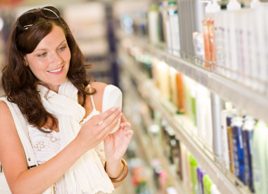The truth about sulfates
Confused about whether this foaming agent is safe? Here’s what you need to know about sulfates

Source: Best Health Magazine, November/December
You likely come into contact with sulfates on a daily basis. But when you see labels that say ‘sulfate free,’ do you wonder if there’s something wrong with this ingredient?
Sulfate compounds (commonly called sulfates) are found in many personal care products such as shampoo, toothpaste, shaving foam, body washes and facial cleansers. In cleansers, they function as surfactants: water- and oil-soluble compounds that, when combined with water, foam and emulsify greasy substances.
‘Sulfates are synthetic ingredients partially based on sulfur, which is derived from petrolatum or other sources,’ explains Yves Lanctôt, a chemist and product consultant in Laval, Que. However, sulfates are not just petrolatum-derived. The largest part of the molecule comes from lauryl alcohol, which is derived from coconut oil or other plants. To make sulfates, lauryl alcohol is reacted with sulfuric acid. Sulfur can be found naturally on earth, but for manufacturing it’s generally produced using petrolatum.
There are hundreds of varieties of sulfates, but sodium lauryl sulfate (SLS) and sodium laureth sulfate (SLES) are the ones most commonly used in personal care products.
‘They’re high foaming, which means that you don’t have to use very much,’ says Michelle Sparrock, executive vice-president of Canadian beauty brand Live Clean. She estimates that more than 90 percent of shampoos and body washes contain SLS or SLES. Live Clean is among a growing number of brands that manufacture zero-sulfate shampoo, promising a gentler approach to hair care.
But are sulfates bad? Health Canada, the European Union and the U.S. Food and Drug Administration (FDA) consider SLS and SLES to be safe ingredients, as does The Cosmetic Ingredient Review, an independent U.S. organization that assesses the safety of ingredients in cosmetics.
The Canadian Cosmetic, Toiletry and Fragrance Association agrees. ‘Both SLS and SLES have been reviewed quite thoroughly, and found to be safe when used as intended,’ says Mike Patton, director of government and media relations for the association.
Lanctôt says that while SLS and SLES are not sensitizers’molecules that cause allergic reactions’they are irritants ‘and in some people can temporarily aggravate the skin, causing redness, dryness and itching. ‘SLES is not as good a detergent as SLS, but it’s a lot milder; SLS is more irritating,’ Lanctôt says. However, a by-product of SLES’the compound 1,4-dioxane”is a carcinogen,’ says Marilyn Patterson. She’s a cosmetic chemist and owner ‘of Natural Cosmetic Solutions Inc., based in Acton, Ont., a developer of skin and hair care products. ‘Manufacturers try to clean it out, but they can only do it to a certain degree,’ she explains.
But Lanctôt estimates that for every 10 million grams of SLES manufactured, a scant 10 grams of 1,4-dioxane are produced. ‘And that’s the raw material,’ he says. ‘So when you put it in shampoo, it’s further diluted.’
Health Canada assessed 1,4-dioxane in 2009 and found that adults’ exposure to it through personal care products is thousands of times lower than the levels that could affect our health. Children’s exposure levels were even lower. Moreover, adds Ashley Lemire, a spokesperson for Health Canada, the claim that sulfates cause cancer is ‘a known myth’ and the miniscule amounts that are in shampoo have been proven not to cause cancer.
Even so, for some companies, going sulfate-free is about sustainability, since petrolatum is a non-renewable resource. (Live Clean, for example, uses surfactants like sodium lauryl sulfoacetate, which is based on renewable coconut oil.) But Ecocert, an international organization with ‘an office in Canada that offers natural and organic certification of eco-friendly products, does approve the use of some sulfates’including SLS and SLES’since they are biodegradable and have low eco-toxicity, meaning they don’t harm water or plant life.
But can sulfates wreck hair or hair colour? ‘Sulfates can fade colour and cause hair to become brittle,’ says Stephanie Binette, marketing director for hair care and hair colour at L’Oréal Paris, which has developed two sulfate-free lines’the colour-care range EverPure, and the EverStrong fortifying line.
With shampoos, sulfate free might mean a higher price point, as other surfactants are more costly and lead to pricier formulations in general. For instance, sulfate-based shampoo can be thickened with an inexpensive ingredient, sodium chloride (simple table salt)’but that thickener does not work in sulfate-free formulations.
Regardless of what you purchase, it’s nice that, these days, there are so many choices on the shelf.
This article was titled "The truth about sulfates," in the November/October 2010 issue of Best Health. Subscribe today to get the full Best Health experience’and never miss an issue!’and make sure to check out what’s new in the latest issue of Best Health.




